Презентация lecture 1 volatile.oils

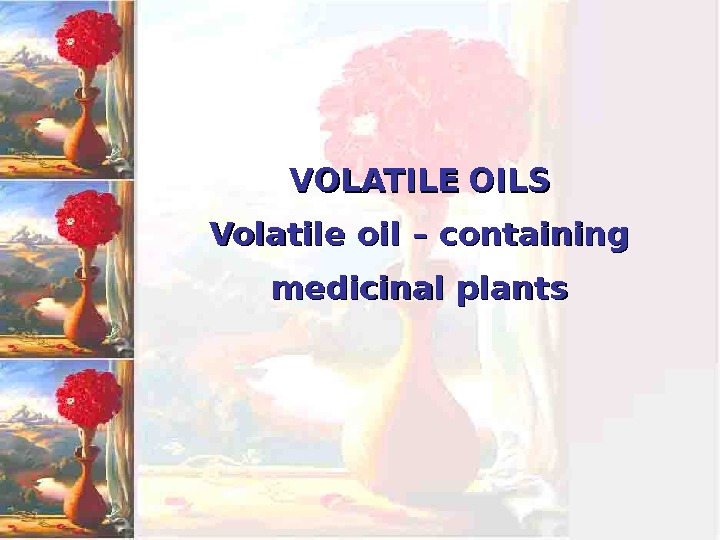

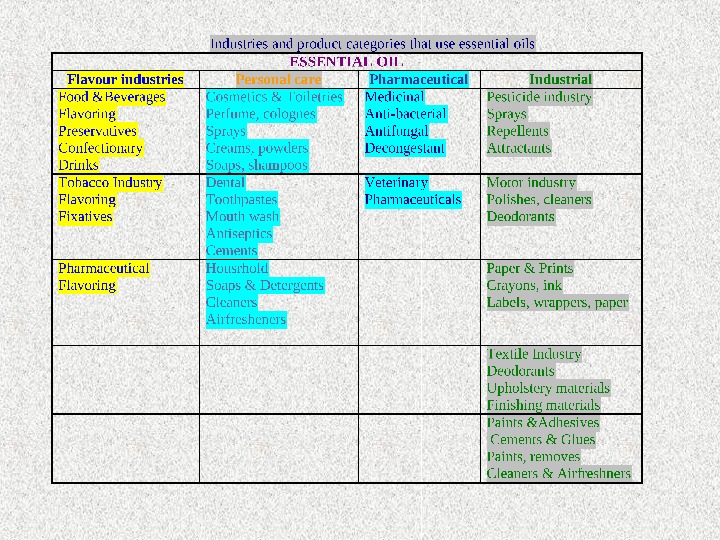


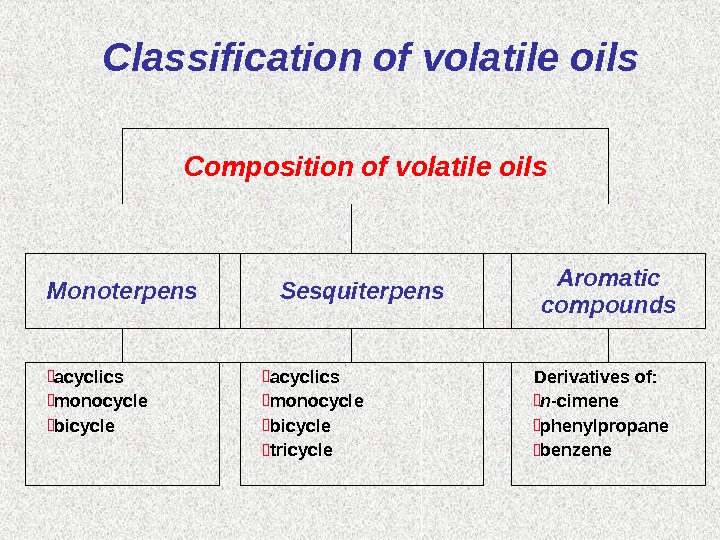
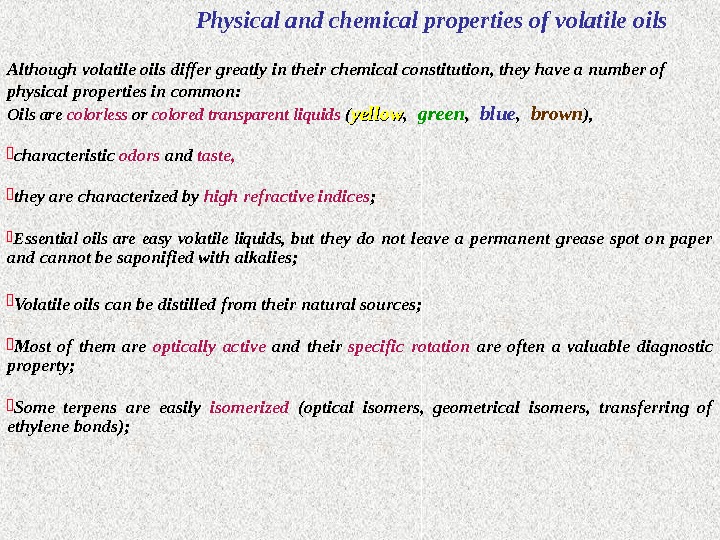
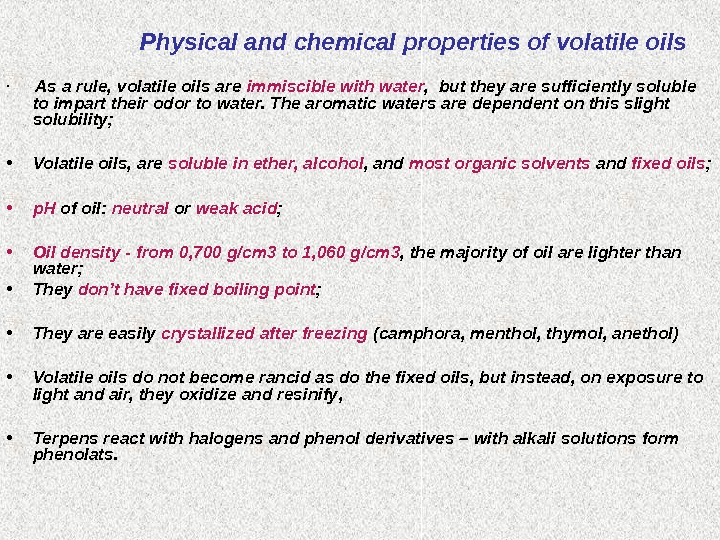
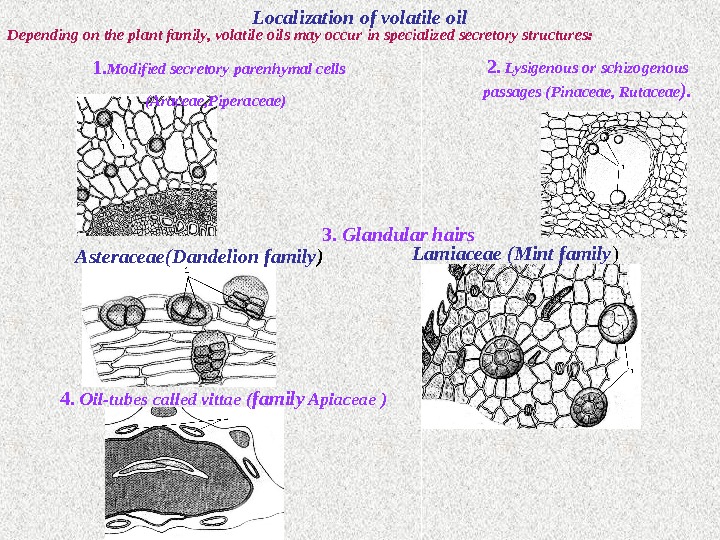
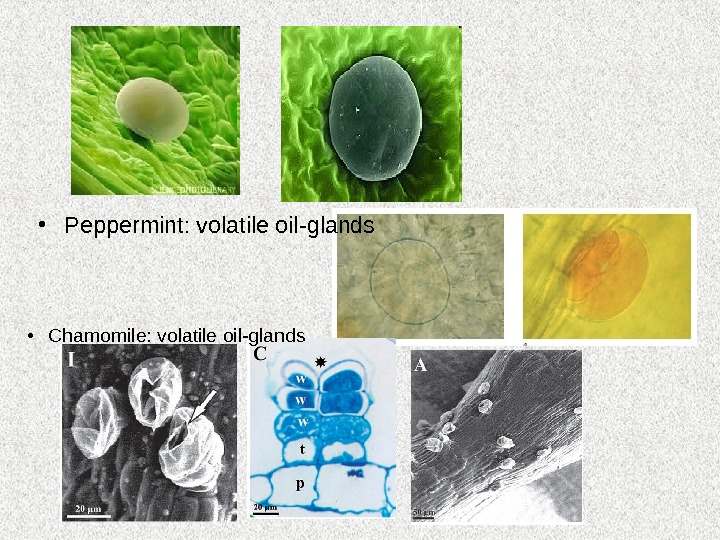

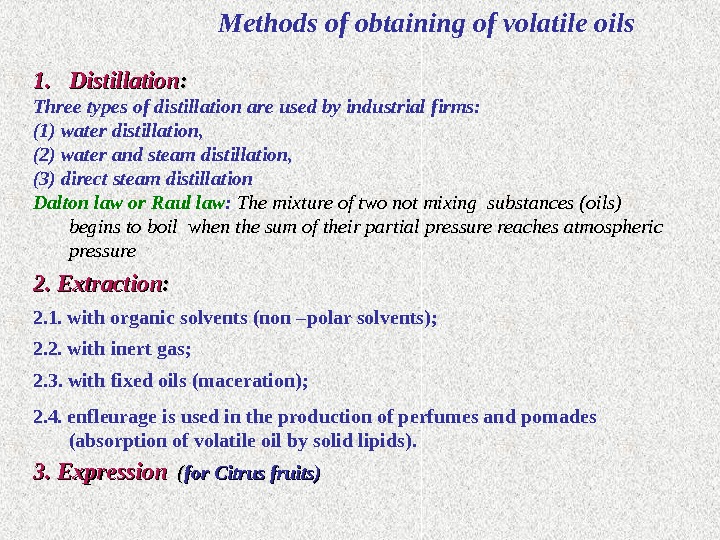

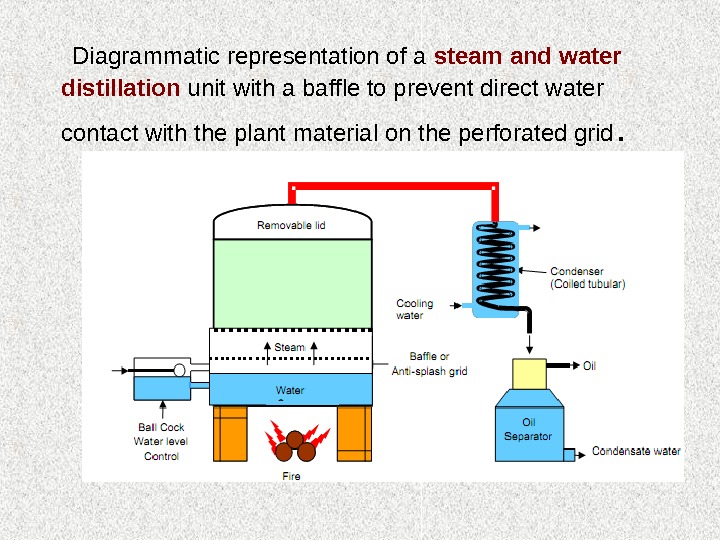
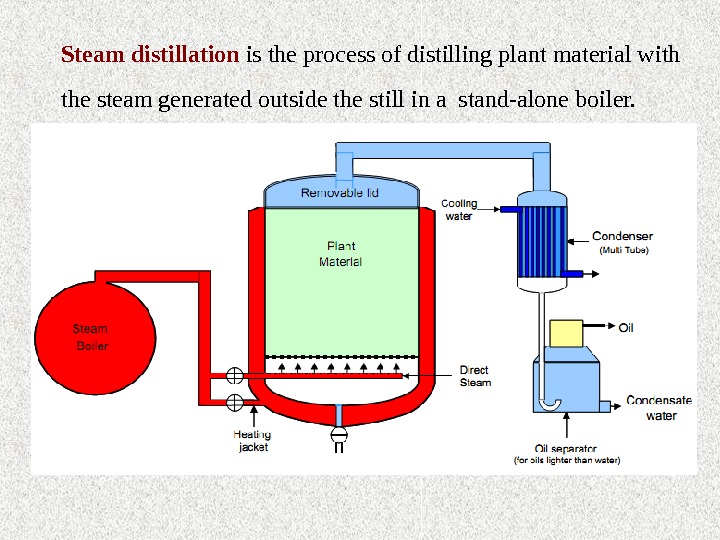
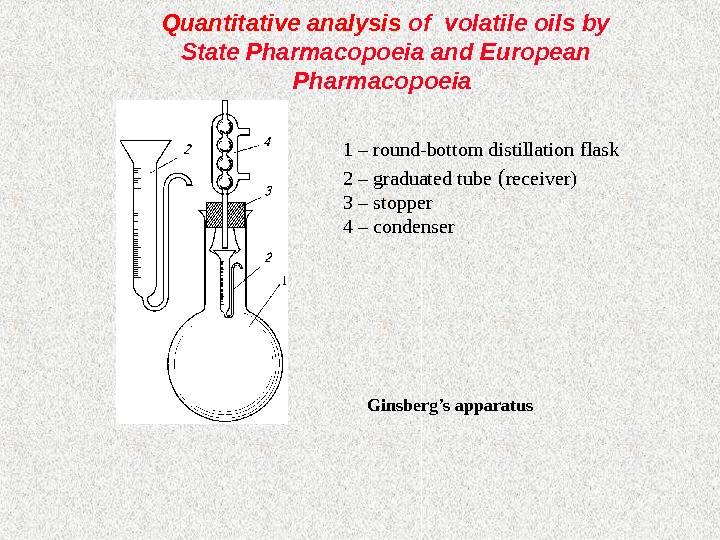
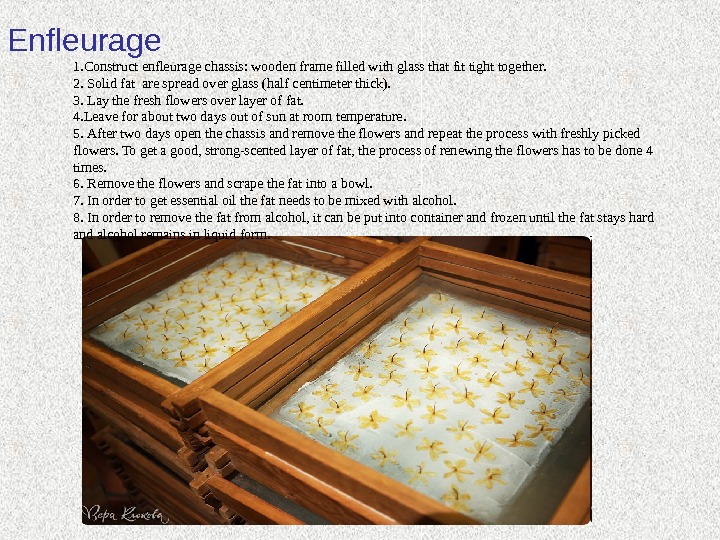
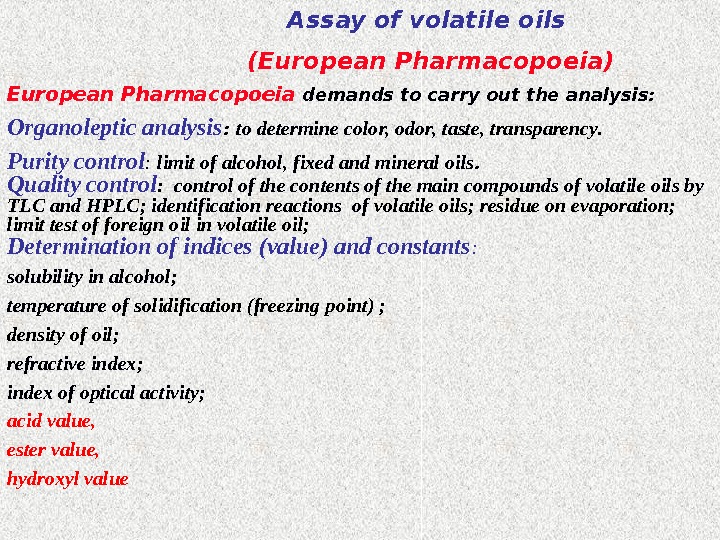
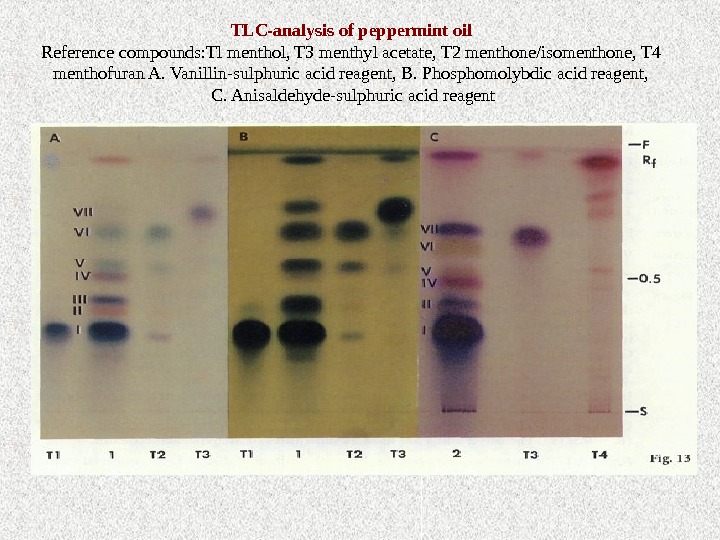

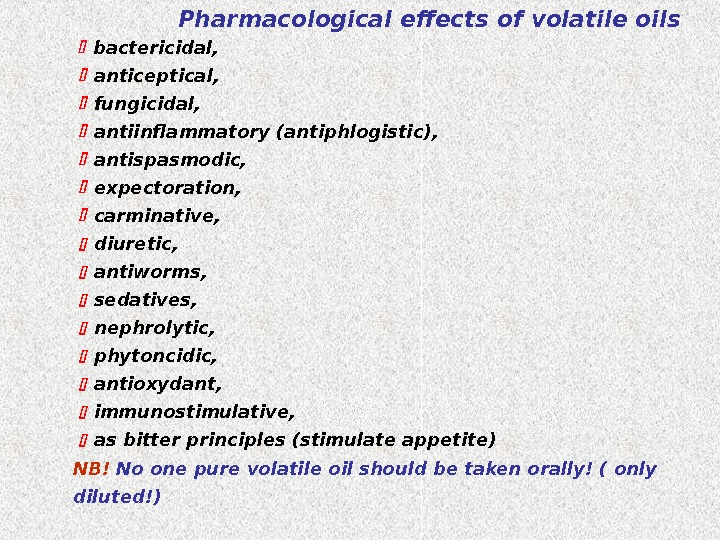
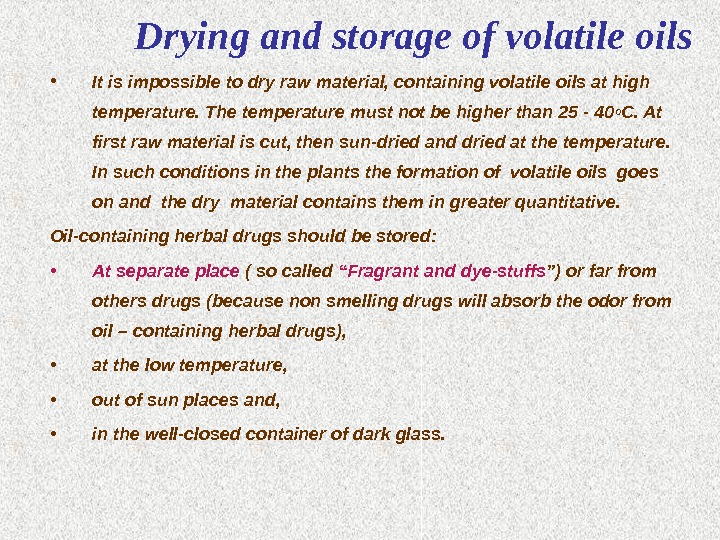
- Размер: 5.1 Mегабайта
- Количество слайдов: 22
Описание презентации Презентация lecture 1 volatile.oils по слайдам
 VOLATILE OILS Volatile oil – containing medicinal plants
VOLATILE OILS Volatile oil – containing medicinal plants
 Volatile oils ( Aetheroleum ) are the odorous principles found in various plant parts. Because they evaporate when exposed to the air at ordinary temperatures, they are called volatile oils, ethereal oils or essential oils. Practically all volatile oils consist of chemical mixtures that are often quite complex; they vary widely in chemical composition. Chemical constituents of volatile oils may be divided into 2 broad classes, based on their biosynthetic origin: (1) terpene derivatives formed via the acetate-mevalonic acid pathway, (2) aromatic compounds formed via the shikimic acid-phenylpropanoid route.
Volatile oils ( Aetheroleum ) are the odorous principles found in various plant parts. Because they evaporate when exposed to the air at ordinary temperatures, they are called volatile oils, ethereal oils or essential oils. Practically all volatile oils consist of chemical mixtures that are often quite complex; they vary widely in chemical composition. Chemical constituents of volatile oils may be divided into 2 broad classes, based on their biosynthetic origin: (1) terpene derivatives formed via the acetate-mevalonic acid pathway, (2) aromatic compounds formed via the shikimic acid-phenylpropanoid route.

 Terpenes are defined as natural products whose structures may be divided into isoprene units (C 5 H 6 ). These units arise from acetate via mevalonic acid and are branched-chain, 5 -carbon units containing 2 unsaturated bonds • Isoprene • Chemical structure of isoprene During the formation of terpenoids, the isoprene units are linked in a head-to-tail fasion and the number of these units incorporated into a particular terpene serves as a basis for the classification of these compounds. • The link of isoprene units in a head-to-tail fasion in geraniol molecule. C H 2 C H 3 C CHCH 2 h e a d t a i l C H 3 C H C H 2 C C H 3 C H 2 O H
Terpenes are defined as natural products whose structures may be divided into isoprene units (C 5 H 6 ). These units arise from acetate via mevalonic acid and are branched-chain, 5 -carbon units containing 2 unsaturated bonds • Isoprene • Chemical structure of isoprene During the formation of terpenoids, the isoprene units are linked in a head-to-tail fasion and the number of these units incorporated into a particular terpene serves as a basis for the classification of these compounds. • The link of isoprene units in a head-to-tail fasion in geraniol molecule. C H 2 C H 3 C CHCH 2 h e a d t a i l C H 3 C H C H 2 C C H 3 C H 2 O H
 Classification of terpenoids
Classification of terpenoids
 Classification of volatile oils Composition of volatile oils Monoterpens Sesquiterpens Aromatic compounds acyclics monocycle bicycle tricycle Derivatives of : n -cimene phenylpropane benzene
Classification of volatile oils Composition of volatile oils Monoterpens Sesquiterpens Aromatic compounds acyclics monocycle bicycle tricycle Derivatives of : n -cimene phenylpropane benzene
 Physical and chemical properties of volatile oils Although volatile oils differ greatly in their chemical constitution, they have a number of physical properties in common: Oils are colorless or colored transparent liquids ( yellow , green , blue , brown ), characteristic odors and taste, they are characterized by high refractive indices ; Essential oils are easy volatile liquids, but they do not leave a permanent grease spot on paper and cannot be saponified with alkalies; Volatile oils can be distilled from their natural sources; Most of them are optically active and their specific rotation are often a valuable diagnostic property ; Some terpens are easily isomerized (optical isomers, geometrical isomers, transferring of ethylene bonds);
Physical and chemical properties of volatile oils Although volatile oils differ greatly in their chemical constitution, they have a number of physical properties in common: Oils are colorless or colored transparent liquids ( yellow , green , blue , brown ), characteristic odors and taste, they are characterized by high refractive indices ; Essential oils are easy volatile liquids, but they do not leave a permanent grease spot on paper and cannot be saponified with alkalies; Volatile oils can be distilled from their natural sources; Most of them are optically active and their specific rotation are often a valuable diagnostic property ; Some terpens are easily isomerized (optical isomers, geometrical isomers, transferring of ethylene bonds);
 Physical and chemical properties of volatile oils • As a rule, volatile oils are immiscible with water , but they are sufficiently soluble to impart their odor to water. The aromatic waters are dependent on this slight solubility; • Volatile oils, are soluble in ether, alcohol , and most organic solvents and fixed oils ; • p. H of oil : neutral or weak acid ; • Oil density — from 0, 700 g / cm 3 t о 1, 060 g / cm 3 , the majority of oil are lighter than water; • They don’t have fixed boiling point ; • They are easily crystallized after freezing (camphora, menthol, thymol, anethol) • Volatile oils do not become rancid as do the fixed oils, but instead, on exposure to light and air, they oxidize and resinify , • Terpens react with halogens and phenol derivatives – with alkali solutions form phenolats.
Physical and chemical properties of volatile oils • As a rule, volatile oils are immiscible with water , but they are sufficiently soluble to impart their odor to water. The aromatic waters are dependent on this slight solubility; • Volatile oils, are soluble in ether, alcohol , and most organic solvents and fixed oils ; • p. H of oil : neutral or weak acid ; • Oil density — from 0, 700 g / cm 3 t о 1, 060 g / cm 3 , the majority of oil are lighter than water; • They don’t have fixed boiling point ; • They are easily crystallized after freezing (camphora, menthol, thymol, anethol) • Volatile oils do not become rancid as do the fixed oils, but instead, on exposure to light and air, they oxidize and resinify , • Terpens react with halogens and phenol derivatives – with alkali solutions form phenolats.
 Localization of volatile oil Depending on the plant family, volatile oils may occur in specialized secretory structures: 1. Modified secretory parenhymal cells (Araceae, Piperaceae) 2. Lysigenous or schizogenous passages (Pinaceae, Rutaceae ). 3. Glandular hairs Asteraceae(Dandelion family ) 4. Oil-tubes called vittae ( family Apiaceae ) Lamiaceae (Mint family )
Localization of volatile oil Depending on the plant family, volatile oils may occur in specialized secretory structures: 1. Modified secretory parenhymal cells (Araceae, Piperaceae) 2. Lysigenous or schizogenous passages (Pinaceae, Rutaceae ). 3. Glandular hairs Asteraceae(Dandelion family ) 4. Oil-tubes called vittae ( family Apiaceae ) Lamiaceae (Mint family )
 • Peppermint: volatile oil-glands • Chamomile: volatile oil-glands
• Peppermint: volatile oil-glands • Chamomile: volatile oil-glands
 • Eucalyptus secretory cavity • Curcuma, parenchyma with secretory cells • Pine: secretory passage
• Eucalyptus secretory cavity • Curcuma, parenchyma with secretory cells • Pine: secretory passage
 Methods of obtaining of volatile oils 1. 1. Distillation : : Three types of distillation are used by industrial firms: (1) water distillation, (2) water and steam distillation, (3) direct steam distillation Dalton law or Raul law : The mixture of two not mixing substances (oils) begins to boil when the sum of their partial pressure reaches atmospheric pressure 2. 2. Extraction : : 2. 1. with organic solvents (non –polar solvents) ; 2. 2. with inert gas ; 2. 3. with fixed oils ( maceration ); 2. 4. enfleurage is used in the production of perfumes and pomades (absorption of volatile oil by solid lipids). 3. 3. Expression (( for Citrus fruits)
Methods of obtaining of volatile oils 1. 1. Distillation : : Three types of distillation are used by industrial firms: (1) water distillation, (2) water and steam distillation, (3) direct steam distillation Dalton law or Raul law : The mixture of two not mixing substances (oils) begins to boil when the sum of their partial pressure reaches atmospheric pressure 2. 2. Extraction : : 2. 1. with organic solvents (non –polar solvents) ; 2. 2. with inert gas ; 2. 3. with fixed oils ( maceration ); 2. 4. enfleurage is used in the production of perfumes and pomades (absorption of volatile oil by solid lipids). 3. 3. Expression (( for Citrus fruits)
 Diagrammatic representation of water distillation unit where the plant material is suspended in water
Diagrammatic representation of water distillation unit where the plant material is suspended in water
 Diagrammatic representation of a steam and water distillation unit with a baffle to prevent direct water contact with the plant material on the perforated grid.
Diagrammatic representation of a steam and water distillation unit with a baffle to prevent direct water contact with the plant material on the perforated grid.
 Steam distillation is the process of distilling plant material with the steam generated outside the still in a stand-alone boiler.
Steam distillation is the process of distilling plant material with the steam generated outside the still in a stand-alone boiler.
 Quantitative analysis of volatile oils by State Pharmacopoeia and European Pharmacopoeia 1 – round-bottom distillation flask 2 – graduated tube ( receiver) 3 – stopper 4 – condenser Ginsberg’s apparatus
Quantitative analysis of volatile oils by State Pharmacopoeia and European Pharmacopoeia 1 – round-bottom distillation flask 2 – graduated tube ( receiver) 3 – stopper 4 – condenser Ginsberg’s apparatus
 Enfleurage 1. Construct enfleurage chassis: wooden frame filled with glass that fit tight together. 2. Solid fat are spread over glass (half centimeter thick). 3. Lay the fresh flowers over layer of fat. 4. Leave for about two days out of sun at room temperature. 5. After two days open the chassis and remove the flowers and repeat the process with freshly picked flowers. To get a good, strong-scented layer of fat, the process of renewing the flowers has to be done 4 times. 6. Remove the flowers and scrape the fat into a bowl. 7. In order to get essential oil the fat needs to be mixed with alcohol. 8. In order to remove the fat from alcohol, it can be put into container and frozen until the fat stays hard and alcohol remains in liquid form.
Enfleurage 1. Construct enfleurage chassis: wooden frame filled with glass that fit tight together. 2. Solid fat are spread over glass (half centimeter thick). 3. Lay the fresh flowers over layer of fat. 4. Leave for about two days out of sun at room temperature. 5. After two days open the chassis and remove the flowers and repeat the process with freshly picked flowers. To get a good, strong-scented layer of fat, the process of renewing the flowers has to be done 4 times. 6. Remove the flowers and scrape the fat into a bowl. 7. In order to get essential oil the fat needs to be mixed with alcohol. 8. In order to remove the fat from alcohol, it can be put into container and frozen until the fat stays hard and alcohol remains in liquid form.
 Assay of volatile oils (European Pharmacopoeia) European Pharmacopoeia demands to carry out the analysis: Organoleptic analysis : to determine color, odor, taste, transparency. Purity control : limit of alcohol, fixed and mineral oils. Quality control : control of the contents of the main compounds of volatile oils by TLC and HPLC; identification reactions of volatile oils; residue on evaporation; limit test of foreign oil in volatile oil; Determination of indices (value) and constants : solubility in alcohol; temperature of solidification (freezing point) ; density of oil ; refractive index; index of optical activity; acid value, ester value, hydroxyl value
Assay of volatile oils (European Pharmacopoeia) European Pharmacopoeia demands to carry out the analysis: Organoleptic analysis : to determine color, odor, taste, transparency. Purity control : limit of alcohol, fixed and mineral oils. Quality control : control of the contents of the main compounds of volatile oils by TLC and HPLC; identification reactions of volatile oils; residue on evaporation; limit test of foreign oil in volatile oil; Determination of indices (value) and constants : solubility in alcohol; temperature of solidification (freezing point) ; density of oil ; refractive index; index of optical activity; acid value, ester value, hydroxyl value
 TLC-analysis of peppermint oil Reference compounds: Tl menthol, T 3 menthyl acetate, T 2 menthone/isomenthone, T 4 menthofuran A. Vanillin-sulphuric acid reagent, B. Phosphomolybdic acid reagent, C. Anisaldehyde-sulphuric acid reagent
TLC-analysis of peppermint oil Reference compounds: Tl menthol, T 3 menthyl acetate, T 2 menthone/isomenthone, T 4 menthofuran A. Vanillin-sulphuric acid reagent, B. Phosphomolybdic acid reagent, C. Anisaldehyde-sulphuric acid reagent
 Analysis of volatile oil Chemical values : acid value, ester value , hydroxyl value ( ester value after acetylation). Acid Value (Ph. Eur. ) The acid value is the number of mg of potassium hydroxide required to neutralise the free acid in 1 g of the substance when determined by the following method, unless otherwise specified in the monograph. This analysis is carried out by alkali titration. Ester Value (Ph. Eur. ) The ester value is the number of mg of potassium hydroxide required to saponify the esters present in 1 g of the substance. This analysis is carried out by back titration. Hydroxyl Value (Ph. Eur. ) The hydroxyl value of a substance is the number of mg of potassium hydroxide required to neutralize the acid combined by acylation in 1 g of the substance.
Analysis of volatile oil Chemical values : acid value, ester value , hydroxyl value ( ester value after acetylation). Acid Value (Ph. Eur. ) The acid value is the number of mg of potassium hydroxide required to neutralise the free acid in 1 g of the substance when determined by the following method, unless otherwise specified in the monograph. This analysis is carried out by alkali titration. Ester Value (Ph. Eur. ) The ester value is the number of mg of potassium hydroxide required to saponify the esters present in 1 g of the substance. This analysis is carried out by back titration. Hydroxyl Value (Ph. Eur. ) The hydroxyl value of a substance is the number of mg of potassium hydroxide required to neutralize the acid combined by acylation in 1 g of the substance.
 bactericidal, anticeptical , fungicidal , anti inflammatory ( antiphlogistic ) , antispasmodic, expectoration, carminative, diuretic , antiworms , sedatives , nephrolytic , phytoncidic , antioxydant , immunostimulative , as bitter principles (stimulate appetite) NB! No one pure volatile oil should be taken orally! ( only diluted!) Pharmacological effects of volatile oils
bactericidal, anticeptical , fungicidal , anti inflammatory ( antiphlogistic ) , antispasmodic, expectoration, carminative, diuretic , antiworms , sedatives , nephrolytic , phytoncidic , antioxydant , immunostimulative , as bitter principles (stimulate appetite) NB! No one pure volatile oil should be taken orally! ( only diluted!) Pharmacological effects of volatile oils
 Drying and storage of volatile oils • It is impossible to dry raw material, containing volatile oils at high temperature. The temperature must not be higher than 25 — 40 o C. At first raw material is cut, then sun-dried and dried at the temperature. In such conditions in the plants the formation of volatile oils goes on and the dry material contains them in greater quantitative. Oil-containing herbal drugs should be stored: • At separate place ( so called “Fragrant and dye-stuffs ”) or far from others drugs (because non smelling drugs will absorb the odor from oil – containing herbal drugs), • at the low temperature, • out of sun places and, • in the well-closed container of dark glass.
Drying and storage of volatile oils • It is impossible to dry raw material, containing volatile oils at high temperature. The temperature must not be higher than 25 — 40 o C. At first raw material is cut, then sun-dried and dried at the temperature. In such conditions in the plants the formation of volatile oils goes on and the dry material contains them in greater quantitative. Oil-containing herbal drugs should be stored: • At separate place ( so called “Fragrant and dye-stuffs ”) or far from others drugs (because non smelling drugs will absorb the odor from oil – containing herbal drugs), • at the low temperature, • out of sun places and, • in the well-closed container of dark glass.

